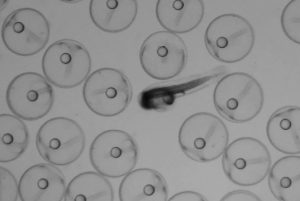Study Develops Fish Genetic Database for Oil Toxicity Analysis
– JANUARY 11, 2018
Researchers developed the first transcriptomic database for mahi-mahi embryos and larvae exposed to oil from the Deepwater Horizon incident. The team assembled over 60,000 transcripts, identified over 30,000 gene sequences, and observed 2,345 genes that differed significantly after exposure to weathered oil. A comparison of the researchers’ approach to a reference-genome-guided approach confirmed their technique’s effectiveness at exploring oil toxicity effects and identifying genes that may act as biomarkers to predict toxicity and oil-exposure recovery. The researchers published their findings in Scientific Reports: Novel transcriptome assembly and comparative toxicity pathway analysis in mahi-mahi (Coryphaena hippurus) embryos and larvae exposed to Deepwater Horizon oil.
Recent studies suggest that crude oil exposure can affect cardiac function, kidney development, and craniofacial skeleton formation in fish embryos and larvae, which could contribute to population decline and mortality. This study addresses the need for improved understanding of molecular events and pathways associated with oil exposure toxicity.
“The molecular mechanisms for developmental toxicity of Deepwater Horizon oil mixture in wild fish are complex,” explained study authors Daniel Schlenk and Genbo Xu. “If we can identify the specific targets for oil and susceptible life stages in animals, we can better evaluate the risks of oil on animal health and focus field assessments and recovery efforts when potential spills occur.”
Researchers analyzed RNA from mahi-mahi embryos exposed to high-energy water-accommodated fractions (HEWAFs) of weathered and unweathered crude oil using high-throughput sequencing. The authors chose oil concentrations of 2% slick oil or 0.09% source oil (LC25) to capture initiating and cascade effects while ensuring that a sufficient signal was observed.
Analysis of oil-exposed larvae identified similarities and differences in genetic responses to different oil types at varying developmental times. Using state of the art bioinformatics pathway analyses, predicted impacts based on RNA expression patterns suggested cardiac hypertrophy, liver proliferation, and cholesterol biosynthesis impairment as toxicological targets. While previous studies confirmed cardiac impairment, the impacts on liver function and cholesterol were unexpected and are currently under investigation. In addition, the team compiled the results into a global transcriptome database, which is applicable to other fish species.
“With this genetic database, we identified the most impacted genes, toxicity pathways, and biological functions in mahi-mahi after Deepwater Horizon oil exposure,” said Schlenk and Xu. “This study provides valuable molecular resources for enhancing the holistic understanding of crude oil toxicity.”
Data are publicly available through the Gulf of Mexico Research Initiative Information & Data Cooperative (GRIIDC) at doi:10.7266/N7MW2F6S and doi:10.7266/N7GX48ND.
The study’s authors are Elvis Genbo Xu, Edward M. Mager, Martin Grosell, E. Starr Hazard, Gary Hardiman, and Daniel Schlenk.
************
This research was made possible in part by a grant from the Gulf of Mexico Research Initiative (GoMRI) to the Relationship of Effects of Cardiac Outcomes in Fish for Validation of Ecological Risk (RECOVER) consortium. Other funding sources included Medical University of South Carolina College of Medicine start-up funds and the Genomics Shared Resource, Hollings Cancer Center.
The Gulf of Mexico Research Initiative (GoMRI) is a 10-year independent research program established to study the effect, and the potential associated impact, of hydrocarbon releases on the environment and public health, as well as to develop improved spill mitigation, oil detection, characterization and remediation technologies. An independent and academic 20-member Research Board makes the funding and research direction decisions to ensure the intellectual quality, effectiveness and academic independence of the GoMRI research. All research data, findings and publications will be made publicly available. The program was established through a $500 million financial commitment from BP. For more information, visit https://gulfresearchinitiative.org/.
© Copyright 2010-2018 Gulf of Mexico Research Initiative (GoMRI) – All Rights Reserved. Redistribution is encouraged with acknowledgement to the Gulf of Mexico Research Initiative (GoMRI). Please credit images and/or videos as done in each article. Questions? Contact web-content editor Nilde “Maggie” Dannreuther, Northern Gulf Institute, Mississippi State University (maggied@ngi.msstate.edu).






